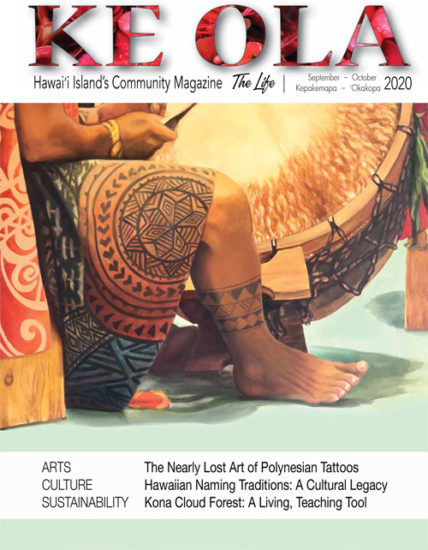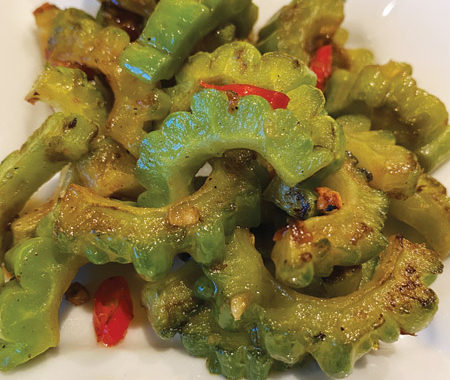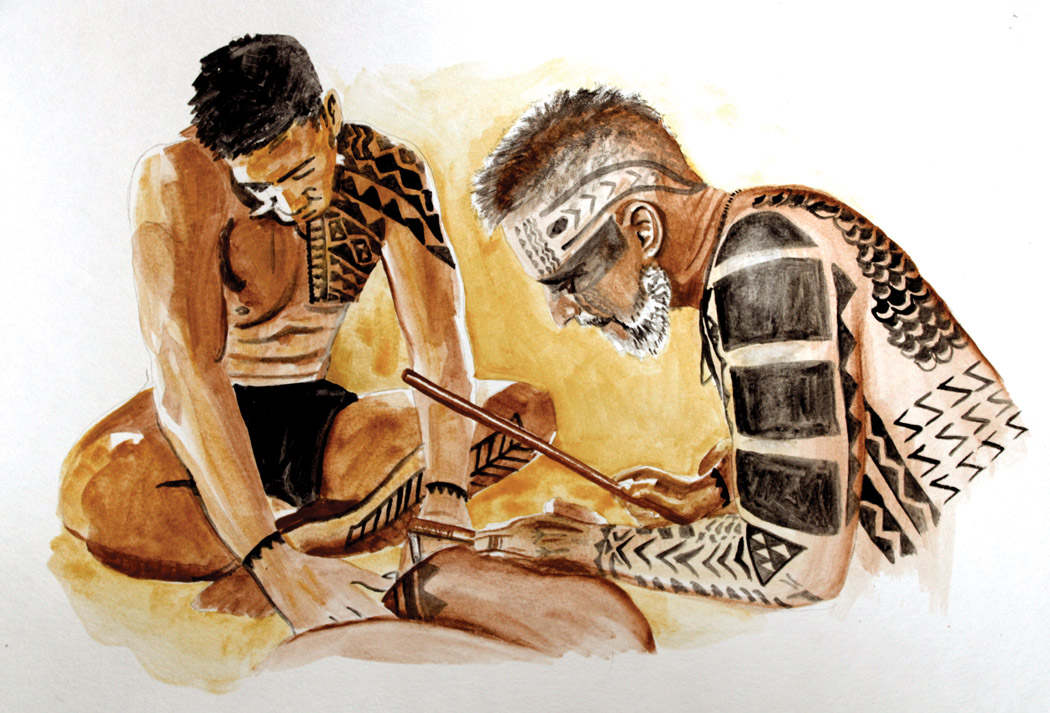
Kākau: The Nearly Lost Art of Hand-tapped Polynesian Tattoos

By Star Bolton
The Polynesians were a seafaring people who navigated the seas and settled in several of the islands of the Polynesian triangle (the Hawaiian Islands being at the top most northern point). The further south you travel, you will hear this art of hand-tapping referred to as tatau which is actually the origin of our English word tattoo. Another word English borrows from the Polynesians is the word taboo, derived from the word tapu (in Hawaiian, kapu), meaning forbidden. As tatau was common for the ali‘i (royalty), the Kahuna Kā Uhi (tattoo priest) had the very special honor of being permitted to perform the act of shedding the blood of the ali‘i, which for anyone else would have been strictly kapu and resulted in the punishment of death.
Kākau is actually two words combined: Kā means to strike and kau means to place, which very literally describes how an uhi (tattoo) is created using the ancient method of hand-tapping. The word uhi also literally means darkening; the result of the practice leaves a permanent image etched into the flesh.
The writer had the pleasure to speak with Kahuna Kā Uhi Kāuhi Keone‘ulaikamakauhi Keli‘iokalani Mākua, the first graduated student of the master who brought this ancient art form back to the Hawaiian Islands, Master Keone Nunes. Keone was titled in Samoa, making Keli‘i the first Kā Uhi to be titled in Hawai‘i by a Hawaiian tattoo master in more than 200 years. Keli‘iʻs name and title was bestowed on him by Sulu‘ape Keone‘ula Nunes.
Now a resident of O‘ahu, Keli‘i’s family is originally from Ho‘okena on Hawai‘i Island. Kā Uhi Keli‘i has spent the last 30 years helping to reawaken this nearly forgotten art form with a handful of dedicated others.
Receiving a traditional Hawaiian hand-tapped tattoo is very different from going to your local tattoo parlor for some ink. In this ancient tradition, the receiver does not get to choose their design. Even though the conceptual consultations may be discussed for many months, the actual artwork is ultimately an improvisation that happens in the moment. The giver and assistants necessary to stretch the skin will pule (pray) over the receiver and ask for guidance from ‘aumākua (family gods) or ancestors to aid the process. This can sometimes result in unexpected additions or omissions to the original design work.
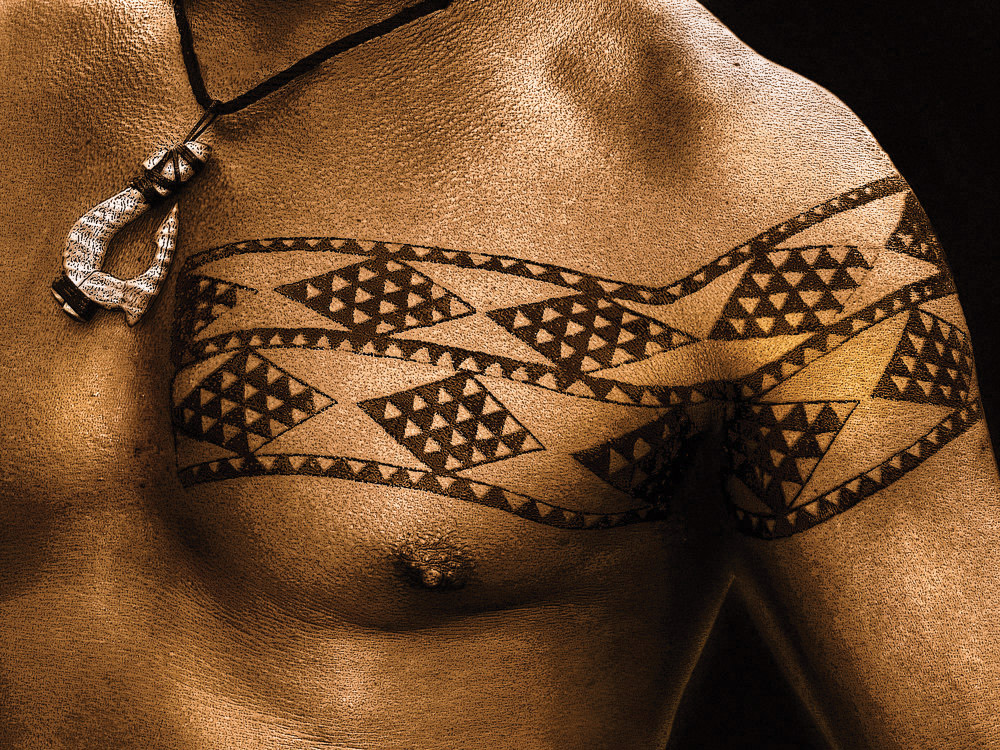
“Sometimes after a session, I will look over the work and see some details I don’t even remember creating,” says Keli‘i of times when he was so entranced in the hypnotic tapping that it felt like his hand was guided outside of his own consciousness. These tattoos are not about ornamenting the body. Aesthetics are secondary to the sacred intentions manifested into the skin to honor one’s ancestors, strengthen a weakness, or enhance an ability.
Reasons for receiving a tattoo could be to honor one’s ancestors, profession, a rite of passage, or ‘aumākua (family gods or spirit animal). A Kā Uhi is well versed in understanding the imagery that represents the genealogy and meaningful symbology of their people. For instance, there is an ancestral lineage that receives a series of dots around the ankle to represent their family’s ‘aumakua, the shark. As the story goes, a woman was swimming in the ocean and a shark started to bite her ankle. When she called out his name, the shark stopped and apologized saying, “From this day on, I will see the teeth marks on your ankle and know it is you, so I won’t make this mistake again.” So now her descendants continue to receive the tattoo of dots around their ankle as a charm to protect them from shark attacks.

In history books, one can read about the striking Pōhaku warriors of Maui who invaded the other islands. These men had tattoos covering the entire right side of their bodies from head to toe. The intention in doing this was to increase the mana (spiritual power) of their masculine warring side and safeguard their weapon-bearing hand with protection. These tattoos intimidated their enemies who would recognize that this was not the usual side of the body for men to tattoo; usually tattoos would be found on the left side of a man’s body to seek a balance in the duality of their nature by enhancing their feminine side with energy.
It is quite interesting to note that this belief of one side of the body being governed by our masculine or feminine nature is a universal idea found in many ancient cultures and indeed corresponds precisely with current neuroscience understandings of brain function. The left side of our brain, which controls the more analytical or strategic functions of the body (masculine qualities), physically governs the right side of the body. The right side of the brain, which controls our intuitive, creative, and nurturing aspects (feminine qualities), governs the left side of our body. When people have a stroke that damages the left side of the brain, they sometimes lose the ability to read and write but can still remember the words to songs, however if the right side of the brain is damaged, they can completely lose their memory and ability to appreciate music.
This idea of tapping into the duality of the human body comes into play even during the application process for the Kā Uhi. Keli‘i explained that even though he is naturally right hand dominant, to tattoo, he had to learn to use his left hand because this is the hand designated for creating and channeling spiritual intent. Using his left hand keeps the act of kākau sacred and set apart from the ordinary actions of common life.
Keli‘i traveled with his teacher, Keone Nunes, to Western Samoa to learn from the masters who do some of the most intricate designs found in the islands. Keli‘i studied for 26 years before he was titled a Kā Uhi by his teacher. His training consisted of learning to understand the meanings of (and ability to replicate) ancestral designs, the creation of his tools and supplies, and also understanding the human body, as a doctor would, to be able to safely practice this ancient art. There are a lot of lessons that need to be passed down directly from person to person, as this is not an art form that can be studied from a book.
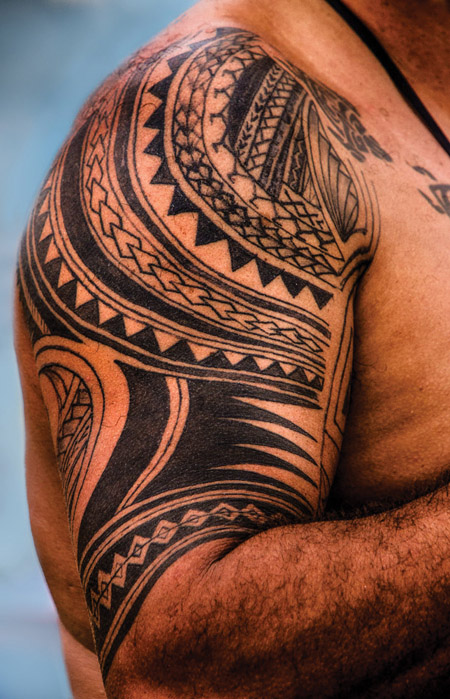
It is only relatively recently that we have the Hawaiian language in written form (since 1820, exactly 200 years ago) and there is nearly no documentation of the designs with their meanings, so those interested are reliant upon the memory of tattoo priests. However, along with the documentation of the Hawaiian language by the American missionaries, came the decline in the acceptance and desire to receive traditional hand-tapped tattoos. Tattoos became less fashionable during the rise of Christianity. Practice of this art form was nearly forgotten with several practitioners opting for the faster, more convenient methods of using a modern tattoo machine to give tattoos.
Most of the documentation that we have of ancient tattoo designs comes from two sources: 1) the artwork of sailors or missionaries who worked from memory and were not fully able to comprehend the work that they were observing, and 2) bodies of the dead that have been found in various disturbed burial sites throughout the islands. Thankfully the information was not completely lost and there are several teachers throughout the Polynesian islands who have been able to share and train one another to pass on these very important traditions. In fact, Kahuna Kā Uhi Keli‘i has started a hālau (school), called Ka Pa o Hunohunoholani, for training the next generation of tattoo priests to continue this sacred work.
Star Bolton, the writer of this story, had heard that it would be impossible for someone without Hawaiian lineage to receive a traditional hand-tapped tattoo. Keli‘i informed her that this is not the case; however, a Kā Uhi will not work on just anyone. Someone desiring a traditional hand-tapped tattoo must be able to articulate their intentions for receiving the uhi and be found worthy by the Kā Uhi.
‘Awa would be served ceremonially before and after the application for all of the participants involved. This might be to reduce the discomfort of the process, as it relaxes the muscles and often produces a numbing effect. Hand-tapping requires two hands to execute, and other people beyond the tattooist must be present to help stretch the skin. Sessions can last from 3–5+ hours and some tattoos require multiple sessions to fully complete. This can be a very painful process to endure. A warrior unable to endure the pain of the procedure would be physically marked as a coward, wearing his shame in his incomplete tattoo.
Many people continue to add designs to their bodies throughout their lives to memorialize rites of passage marking their personal history. Traditionally, a child’s coming of age would be cause for receiving a tattoo that runs the length of the leg (the right leg for women and the left leg for men). Thighs, loins, and buttocks were frequently mentioned in reports of sailors as being fully adorned with intricate line work on men and women alike.
Polynesian tattoo has a very profound ability to connect one to the history of their ancestry while defining them as a unique individual in their present day community. ❖
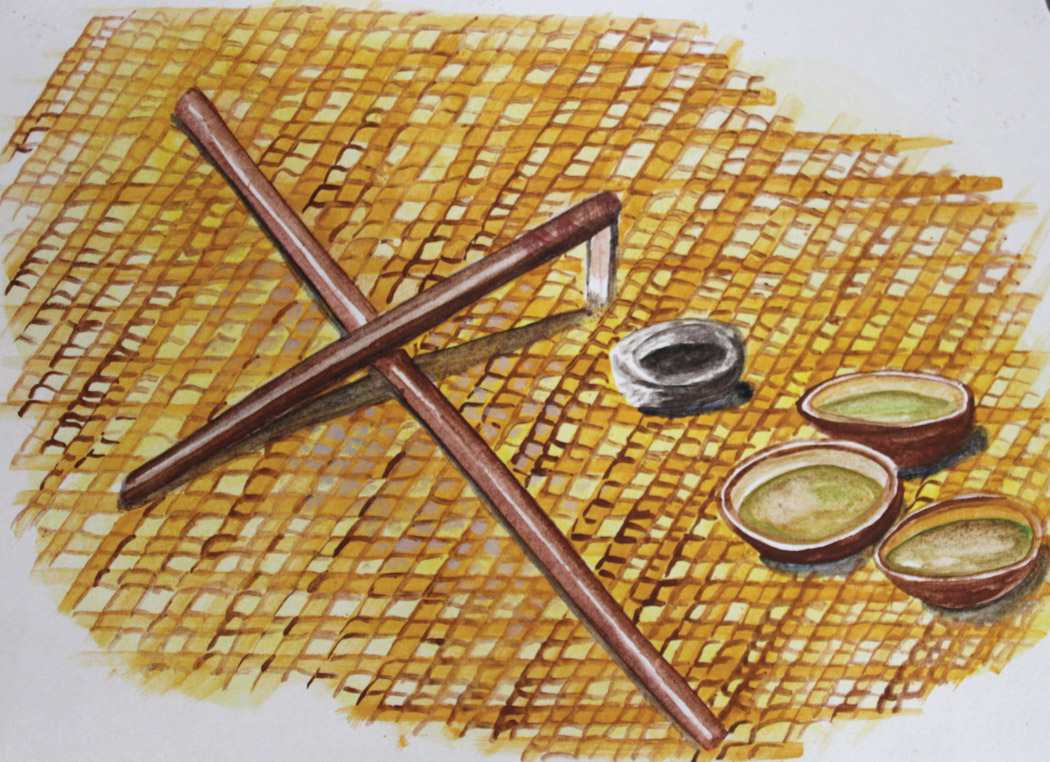
For more information: kelii@kauhi.com
